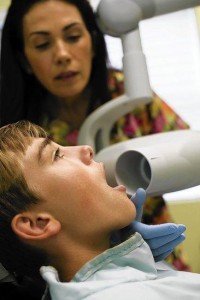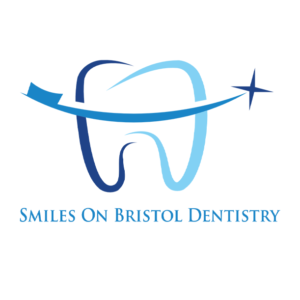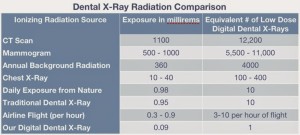We have all gone to the dental office for an exam, you begin with the paper work and then they call you in for your x-rays or radiographs. The dental x-rays help the dentist give a better diagnostic, x-rays can detect caries and other problems such as cyst or abnormalities in the mouth. The amount of x-rays depend on if you’re a first time patient or a returning patient. If you’re a fist time patient a full mouth x-ray will most likely be taken, this will give the dentist a better look of all your teeth. The amount of x-rays also depend on the age of the patients, children requiring less x-rays. If you’re a returning patient the amount of x-rays will be minimal. Some dentist also recommend panoramic x-rays this x-ray captures the entire mouth in a single shot.
There is new dental technology that your dentist may be using in his office, an example is digital x-rays. Digital x-rays have revolutionize the dental field. With digital x-rays you are exposed to less radiation than the traditional x-rays. Digital x-rays are automatically sent to the computer rather than taking the traditional x-ray and developing in a dark room. There are many benefits in using this technology, your dentist can email or print, enlarge, and even compare images. The amount of radiation when x-rays are taken are very minimal. The radiation is focused on just the site and the dental walls have a shield from scattered radiation. The technicians are trained to take the best x-rays as possible to avoid retakes.
When taking x-rays the assistant or x-ray technician will place a lead apron this helps protect the patient from the scattered radiation. All people operating the x-ray machine are trained and license to take x-rays. The amount of radiation from the x-ray unit is lower than background radiation. Background radiation is radiation from sun, soil, rocks, buildings, air, and water. It is very important to tell the x-ray technician if you are pregnant or expecting to be. Your dentist may just start with a visual exam and then continue with x-rays after pregnancy. This of course if the patient is not in pain or discomfort.
Protecting the patient from radiation from dental x-rays is the main focus of a technician. There are ways you can help in minimizing your dental x-rays, letting the technician know of any recent x-rays, co-operating as best as possible to avoid retakes, and avoid going to multiple dental offices to avoid full mouth x-rays. Brushing and flossing to avoid caries also play a role in minimizing x-rays, some procedures require x-rays. If you have any questions regarding radiation from dental x-rays you can contact your friendly staff at Smiles on Bristol Dentistry. /contact-us/


